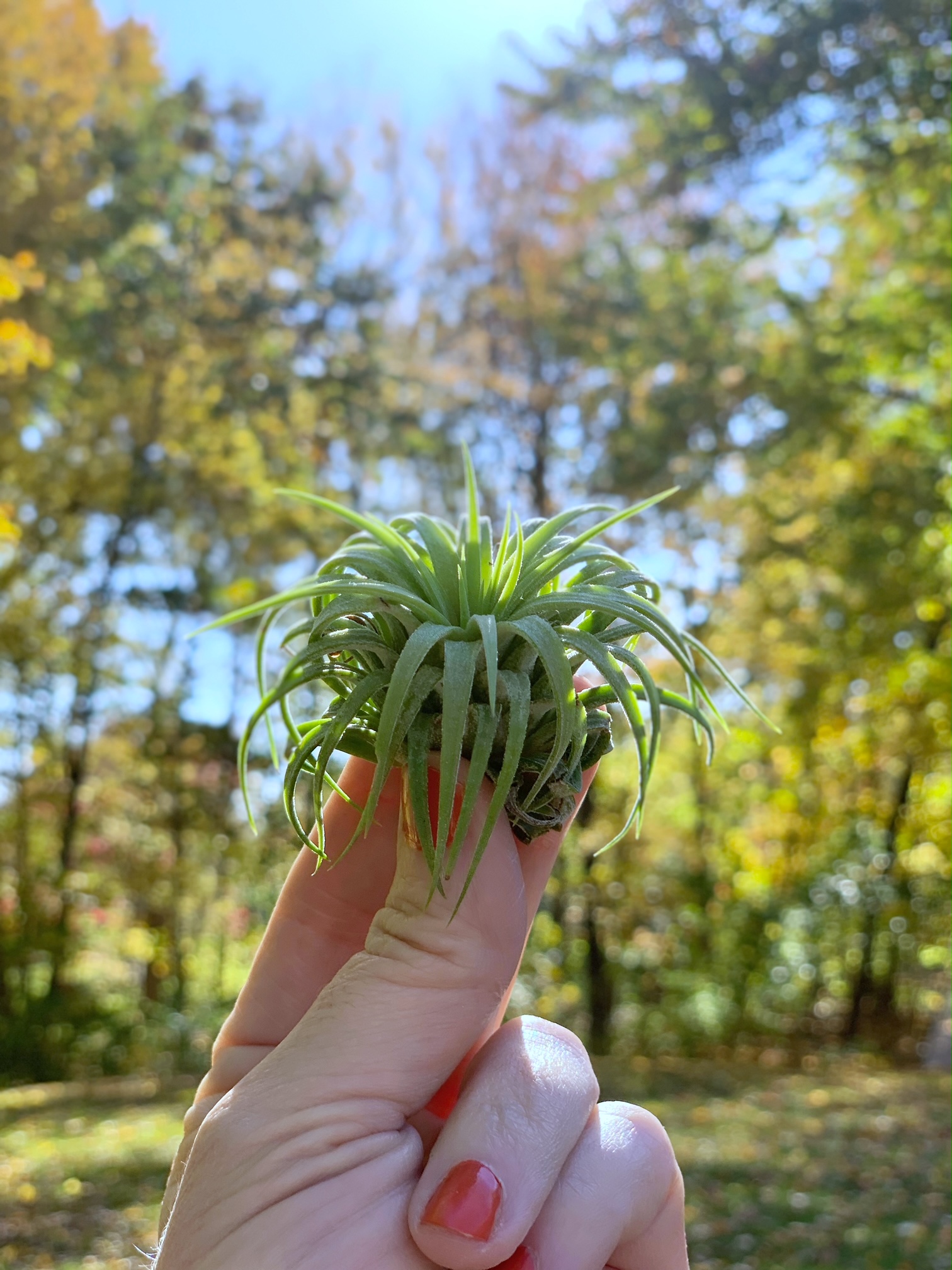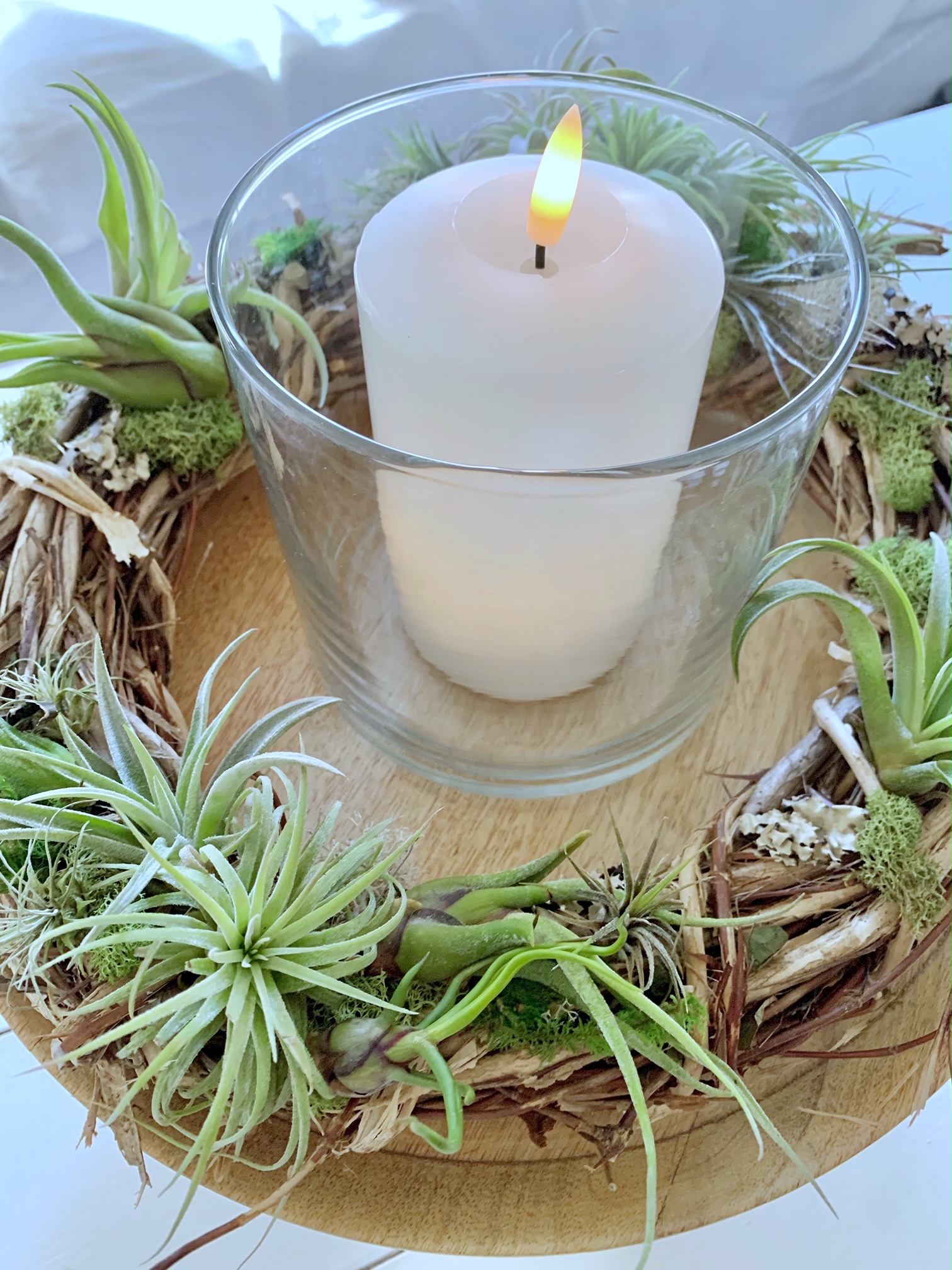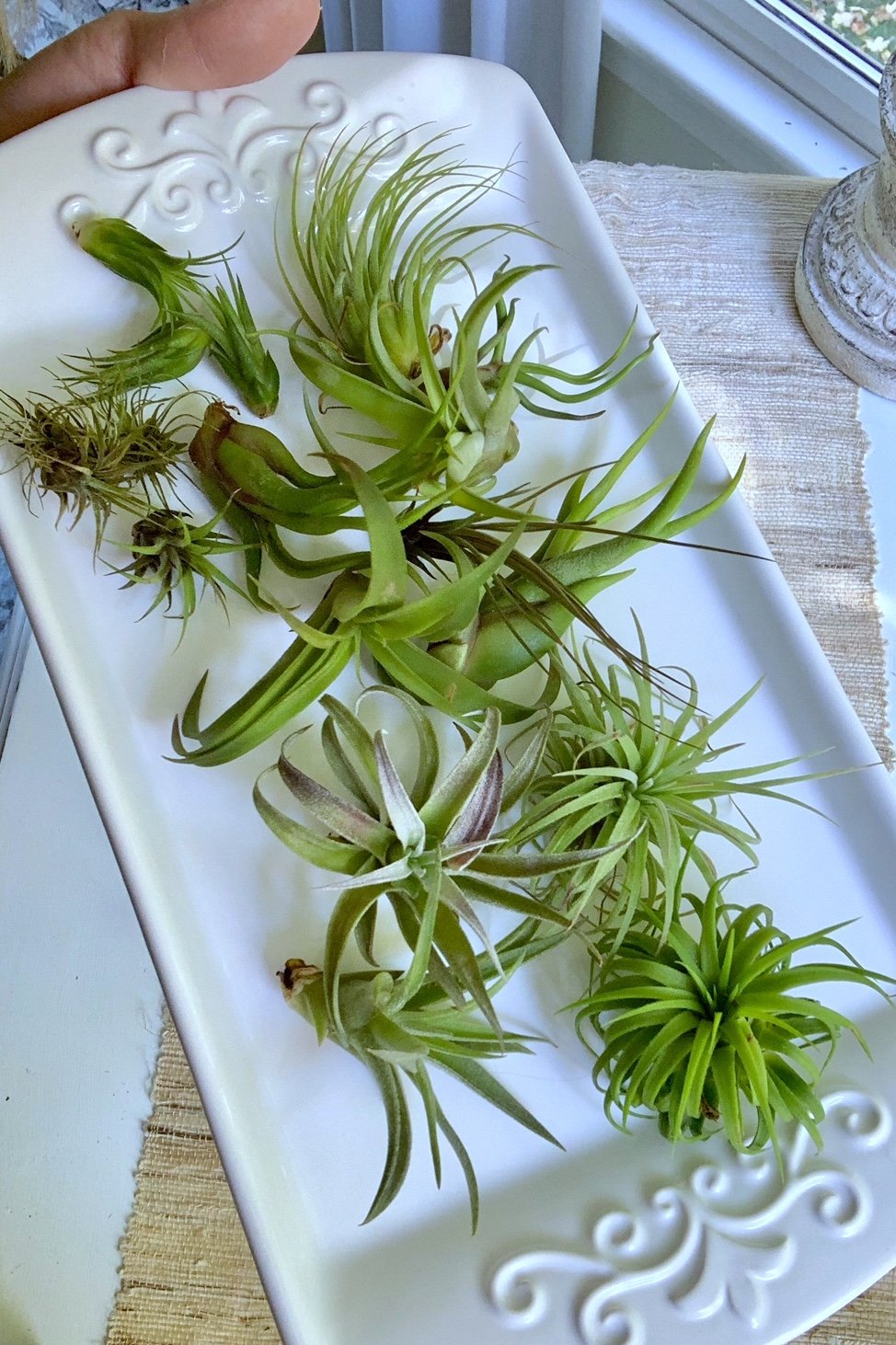Many new air plant parents make the mistake of thinking that air is the only element these unique plants need to thrive. But the truth is while air plants are unique in that they do not need soil, they do need proper sun and water to grow!
In this post, Do Air Plants Need Sun? (Choosing the Ideal Spot), I'll help you determine where to place your air plants for the perfect sun exposure and help you provide the optimal growing environment for these new members of your plant family.

*This post includes affiliate links, for more info on affiliate links visit here
Jump to:
- About Air plants (Tillandsias)
- The fuzzy stuff - (Trichomes)
- Choosing the best light
- Supplementing with artificial grow lights
- Acclimating Air plants to light changes
- Sunlight and Air plant watering needs
- Troubleshooting
- Signs your Air plant is getting too much light
- Signs your Air plant isn't getting enough light
- Light imbalance cheat sheet for Air plants
- Seasonal sunlight considerations
- Frequently asked questions
About Air plants (Tillandsias)
Tillandsias, commonly known as air plants and lovingly referred to as "Tillies", are a genus of of about 300,000 different species of epiphytes (plants that do not need soil to grow). Epiphytes species include Spanish moss (picture Spanish moss hanging from tree branches) and plants in the bromeliad family. Their natural habitats are in the mountains and forests of Central and South America. In nature, epiphytes will often grow on another plant or object that supports them.
In a home environment, you can mimic its native habitats by placing indoor air plants in and on various decorative items such as glass terrariums, glass globes, or hanging macrame structures. The freedom of not having to worry about soil lets you use your creative side with your air plant display.

The fuzzy stuff - (Trichomes)
Before we jump into lighting I think it would be helpful to know what a typical, healthy air plant looks like. This will help you troubleshoot if your plant starts to run into trouble. These easy-care house plants have shallow to no roots therefore soil is not needed for them to grow. However, what is needed for all varieties of air plants is a healthy coat of trichomes. Trichomes are the "fuzzy sweater" or tiny scales on the leaves of air plants that help the plant absorb water from the surrounding air. Trichomes also block harmful radiation from the sun. This fuzzy white coat on the leaves pulls important nutrients and moisture from the air so while on some plants it looks odd - if not concerning - make no mistake about it, this fuzzy coat is vital for survival.
All Tillies need adequate space with good air circulation so the trichomes can effectively do their job. Expect greener varieties like Tillandsia Bulbosa to have healthy fleshy leaves with fewer trichomes. These varieties can use less light exposure and higher humidity than other varieties. The white or grayish-green types (i.e. Tillandsia Xerographica) may appear less fleshy and can handle almost full sun, and less humidity.

Choosing the best light
Let’s go over some tips for choosing the ideal location in your home so your air plants get enough light.
- Air plants need 4-6 hours of bright, indirect sunlight per day for optimal growth.
- Place them 1-3 feet away from an east- or west-facing window to provide bright indirect light. South-facing windows may be too intense unless filtered.
- North-facing windows can work if the plants are within 1 foot of the window. Supplement with grow lights.
- Avoid placing plants on windowsills where direct outdoor sunlight can scorch leaves.
- Sheer curtains can help filter intense light if needed. Monitor for signs of too much sun.
- Rotate plants periodically for even lighting on all sides.
- In low-light rooms, place plants within 6 inches of bright grow lights for 12-14 hours daily.
Following these guidelines will help ensure your air plants receive the right balance and intensity of light. Adjust positions gradually if moving to a new spot. Consistent bright, indirect light keeps air plants thriving!

Supplementing with artificial grow lights
If natural sunlight in your home is inadequate, providing artificial grow lights can give your air plants the additional light they need.
- LED grow lights designed specifically for plants are ideal, as they emit a full light spectrum. Avoid standard incandescent bulbs.
- Air plants should be positioned 6-12 inches from the grow light source to maximize benefits without scorching.
- Provide grow lights for 12-14 hours per day. Use a timer to maintain optimal photoperiods.
- Adjustable grow lights allow you to change the height as your plants grow. Flexible gooseneck styles are ideal.
- Grow lights can be used alone in low-light rooms or combined with a sunny window to supplement natural light.
Providing full spectrum LED grow lights on a consistent daily schedule will help ensure your air plants receive ample light to stay happy and healthy when sunshine is scarce.
Acclimating Air plants to light changes
When acclimating air plants to varying light conditions, it's crucial to take a gradual approach to prevent any potential shock. To prepare your air plants for increased or decreased light, follow these essential tips. For transitioning to brighter light, start by placing them in a spot with indirect sunlight before gradually introducing them to more intense light. This method ensures they adapt to the new conditions without getting sunburned. Conversely, if you're moving them to lower light levels, begin by shifting them to a shadier location with filtered light and then further adjust their placement.
By easing your air plants into their new lighting environment, you'll help them thrive while minimizing the risk of stress or damage from sudden light changes.

Sunlight and Air plant watering needs
The amount of sunlight your air plants receive plays a crucial role in determining air plants watering needs. It's a direct relationship: as sunlight intensity increases, so does the frequency of misting required. Air plants exposed to brighter, sunnier locations will lose moisture more rapidly, and thus, they demand more frequent misting sessions to maintain their hydration levels.
Understanding this balance ensures your air plants receive the right amount of moisture, keeping them healthy and thriving in their light-rich environment.
Troubleshooting
- Artificial Lighting - LED or full-spectrum fluorescent lights specifically designed for growing plants is recommended. Give your air plants about 12 hours a day of artificial light and be sure to place them approximately 12" away from the light source. Standard (incandescent) bulbs do not emit enough light to provide proper lighting for your air plants.
- Creating Indirect Light - Moving your air plants away from direct sunlight by a few feet will keep them from getting too much sun. You could also reduce sun exposure and create filtered light using a sheer curtain between the plants and the window.
- Low-light Options - As mentioned above, air plants will survive in low-light spaces just be sure to move them periodically into a sunnier spot.

Signs your Air plant is getting too much light
Air plants can receive too much sunlight and "sunburn." The first sign of this is the wilting of the leaves. Wilting may also indicate a lack of water so if you've been providing adequate water wilting is more than likely due to too much sun. Changes in leaf color may also mean your plant is receiving too much sun, specifically yellow or orange leaves. Try moving your plants further from the sun source.

Signs your Air plant isn't getting enough light
If your air plant isn't getting enough light you may notice a fading of the color of the leaves. The plant will also have limited to no growth and could become soft. The loss of a good coat of trichomes (fuzzy leaves) may indicate that a plant is in need of a more sunny location for optimum growth.
Light imbalance cheat sheet for Air plants
| Signs of Too Much Light | Signs of Too Little Light |
|---|---|
| Brown or white spots on leaves | Slow or stunted growth |
| Leaf desiccation (drying out) | Elongated, stretched-out growth |
| Leaf tip burn or scorching | Loss of color, appearing pale or dull |
| Overly dry and crispy leaves | Tilted or wilted appearance |
| Signs of wilting, especially during hot conditions | Reduced or no flowering |
| Leaf edges turning brown | Leggy or weak stems |
| Sunburned appearance | Reduced or no flowering |

Seasonal sunlight considerations
Summer
Summer sun:
Be wary of direct light, especially with the stronger summer sun. You may find that you need to move the location of your air plant display to a different window or further away from a light source in the summer months. Also, keep in mind that with more light, air plants will often need more water, so you may have to adjust your watering schedule to ensure your plants are getting enough water for the increased summer sunlight.
Air conditioning:
Be sure to keep your air plants away from an AC vent as this tends to dry them out.
Moving air plants outside:
If you live in a cooler climate where your air plants are kept mostly inside, consider bringing them outside during the more temperate summer months. If you do so, keep in mind the plants may need an adjustment in their care routine as they acclimate to the new outdoor environment.
Winter
Shorter days:
Shorter days mean less sunlight during the winter months. You may need to adjust the placement of your air plants to ensure they get adequate indirect bright light.
Heat:
As with air conditioning heat can affect your air plants if you place them too close to a vent. Heat in a home can also dry out the air which may result in having to increase watering.
Moving air plants inside:
If you are in a climate that dips below 50 degrees you will need to move your Tillies inside for the winter. Keep in mind, air plants are tropical plants and most Tillies prefer temperatures between 50-90 degrees.
Frequently asked questions
While air plants prefer bright light, they can adapt to lower light levels. Just be mindful to provide them some indirect light.
Signs of too much sunlight include brown or white spots on leaves, wilting, and overly dry or crispy foliage.
Yes, you can, but protect them from harsh sun and extreme weather conditions. They often thrive on patios and under shaded trees.
If your air plant lacks sunlight, it may appear pale or grayish. Consider relocating it to a brighter spot or supplementing with artificial light.
Yes, periodically rotate your air plants to ensure all sides receive even light, promoting balanced growth.
While they prefer natural light, air plants can do well under artificial lighting if it provides adequate brightness. LED or fluorescent lights are good options.
Avoid placing air plants in direct contact with windows, as extreme temperatures and sun exposure can be detrimental. Maintain some distance from the glass.
Xeric and mesic air plant varieties differ in their light needs. Xeric plants, adapted to arid environments, thrive in bright, indirect sunlight and can tolerate more direct light than their mesic counterparts. They should be exposed to increased sunlight, which may necessitate more frequent misting. In contrast, mesic air plants, hailing from humid tropical regions, prefer filtered or indirect light. Too much direct sunlight can harm them, causing leaf scorch and stress. It's essential to understand the light preferences of your specific air plant variety to ensure they receive the right amount of light for their well-being.
You can purchase air plants from various sources. Local nurseries, online retailers like Amazon and Etsy, plant shows, farmers' markets, specialty plant stores, local florists, and air plant shows and festivals are all great places to find air plants. Each option has its own advantages and unique selections. For more detailed information on where to buy air plants and additional tips for finding the best sources, check out my blog post, "Where to Buy Air Plants." It provides comprehensive insights into locating healthy and authentic air plants to add to your collection.
If you're new to growing air plants, I highly recommend checking out my complete care guide - How to Keep Air Plants Alive: Tips for Thriving Tillandsias. This in-depth post shares all my best tips and advice for providing the ideal sunlight, watering properly, increasing humidity, troubleshooting issues, creative display ideas, and more. It's the perfect beginner's guide covering everything you need to know to keep your air plants healthy and happy!

Thanks for visiting the blog today for this, Do Air Plants Need Sun? (Choosing the Ideal Spot) post. You may have noticed that I didn't write about proper watering for air plants. I omitted watering guidelines because I felt that topic needed its very own post! So please visit, how often to mist air plant post for the best way to water these low maintenance plants and for other important air plant care tips. To make this candle ring from air plants visit my Where to find Air plants post. For more plant ideas and care please visit my Indoor Plants page.
Keep Growing Friends!







